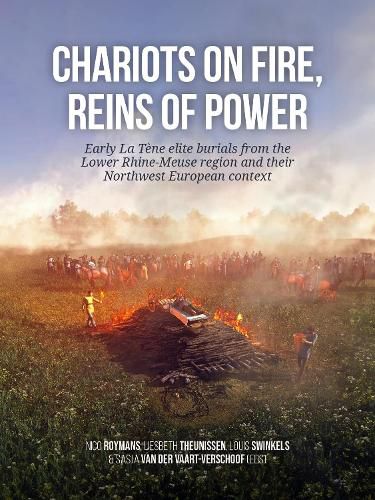Readings Newsletter
Become a Readings Member to make your shopping experience even easier.
Sign in or sign up for free!
You’re not far away from qualifying for FREE standard shipping within Australia
You’ve qualified for FREE standard shipping within Australia
The cart is loading…






'Chariots on Fire, Reins of Power' presents the first comprehensive overview of 5th century BC elite graves from the Lower Rhine-Meuse region. Characterised by imported grave goods such as bronze vessels, horse tack, weapons and occasionally two-wheeled vehicles, these strikingly rich cremation burials are the northernmost representatives of an elite culture that had its roots in the Late Hallstatt and Early La Tene culture of more southern regions in France and the German Rhineland. This book is the result of an interdisciplinary study of this northern group of graves, prompted by the recent discovery of a new chariot burial at Heumen, the Netherlands. It will be of great interest to anyone interested in the material culture of the Iron Age and the wider debate about social transformations in the European region at this time. All elite graves in the area were reexamined from a practice perspective, including the examination of all grave goods using a wide range of techniques, including examination of use-wear traces and XRF-analysis. Physical anthropological study of cremated remains revealed new insights into the ages and sex of the elite dead, and strontium analysis provided valuable insights into Middle Iron Age mobility. Technical study from a practical equestrian perspective revealed the presence of both chariots with accompanying draught horses, as well as riding horses that wore elaborately decorated tack. The 5th century BC reveals itself as a highly dynamic period in the study area, with the appearance of elite graves being just one element in the broad spectrum of social changes that occurred during this phase. The urnfields fell into widespread disuse, small new cemeteries with flat graves emerged, a practice of inhumation was introduced in the Dutch river area, and 'Marne ceramics', a new pottery style, spread rapidly. In order to understand these complex regional dynamics, this book proposes a model that allows scope for intensive interregional connectivity, demographic fluctuations and probably also the small-scale immigration of southern groups, not just elites but lower social groups as well.
$9.00 standard shipping within Australia
FREE standard shipping within Australia for orders over $100.00
Express & International shipping calculated at checkout
'Chariots on Fire, Reins of Power' presents the first comprehensive overview of 5th century BC elite graves from the Lower Rhine-Meuse region. Characterised by imported grave goods such as bronze vessels, horse tack, weapons and occasionally two-wheeled vehicles, these strikingly rich cremation burials are the northernmost representatives of an elite culture that had its roots in the Late Hallstatt and Early La Tene culture of more southern regions in France and the German Rhineland. This book is the result of an interdisciplinary study of this northern group of graves, prompted by the recent discovery of a new chariot burial at Heumen, the Netherlands. It will be of great interest to anyone interested in the material culture of the Iron Age and the wider debate about social transformations in the European region at this time. All elite graves in the area were reexamined from a practice perspective, including the examination of all grave goods using a wide range of techniques, including examination of use-wear traces and XRF-analysis. Physical anthropological study of cremated remains revealed new insights into the ages and sex of the elite dead, and strontium analysis provided valuable insights into Middle Iron Age mobility. Technical study from a practical equestrian perspective revealed the presence of both chariots with accompanying draught horses, as well as riding horses that wore elaborately decorated tack. The 5th century BC reveals itself as a highly dynamic period in the study area, with the appearance of elite graves being just one element in the broad spectrum of social changes that occurred during this phase. The urnfields fell into widespread disuse, small new cemeteries with flat graves emerged, a practice of inhumation was introduced in the Dutch river area, and 'Marne ceramics', a new pottery style, spread rapidly. In order to understand these complex regional dynamics, this book proposes a model that allows scope for intensive interregional connectivity, demographic fluctuations and probably also the small-scale immigration of southern groups, not just elites but lower social groups as well.